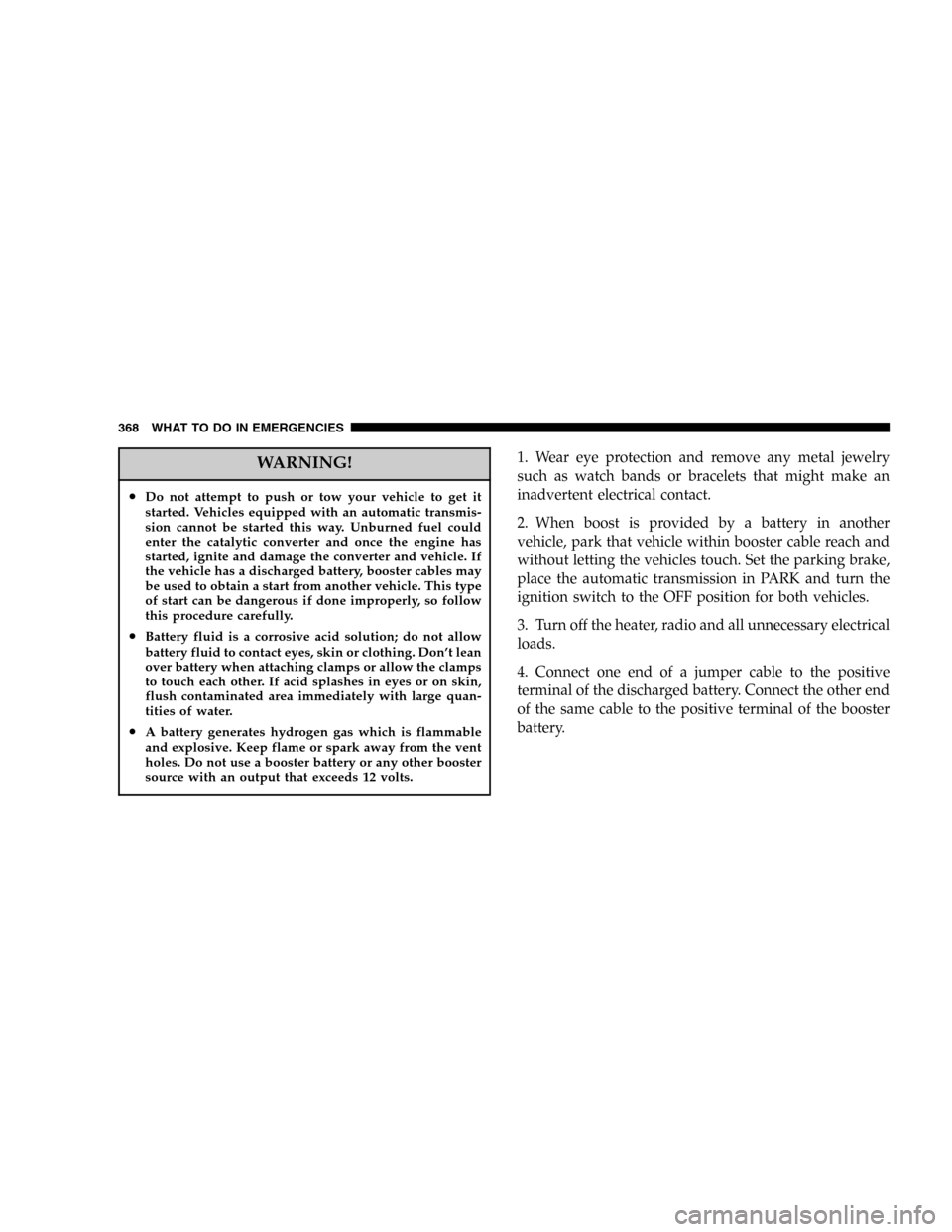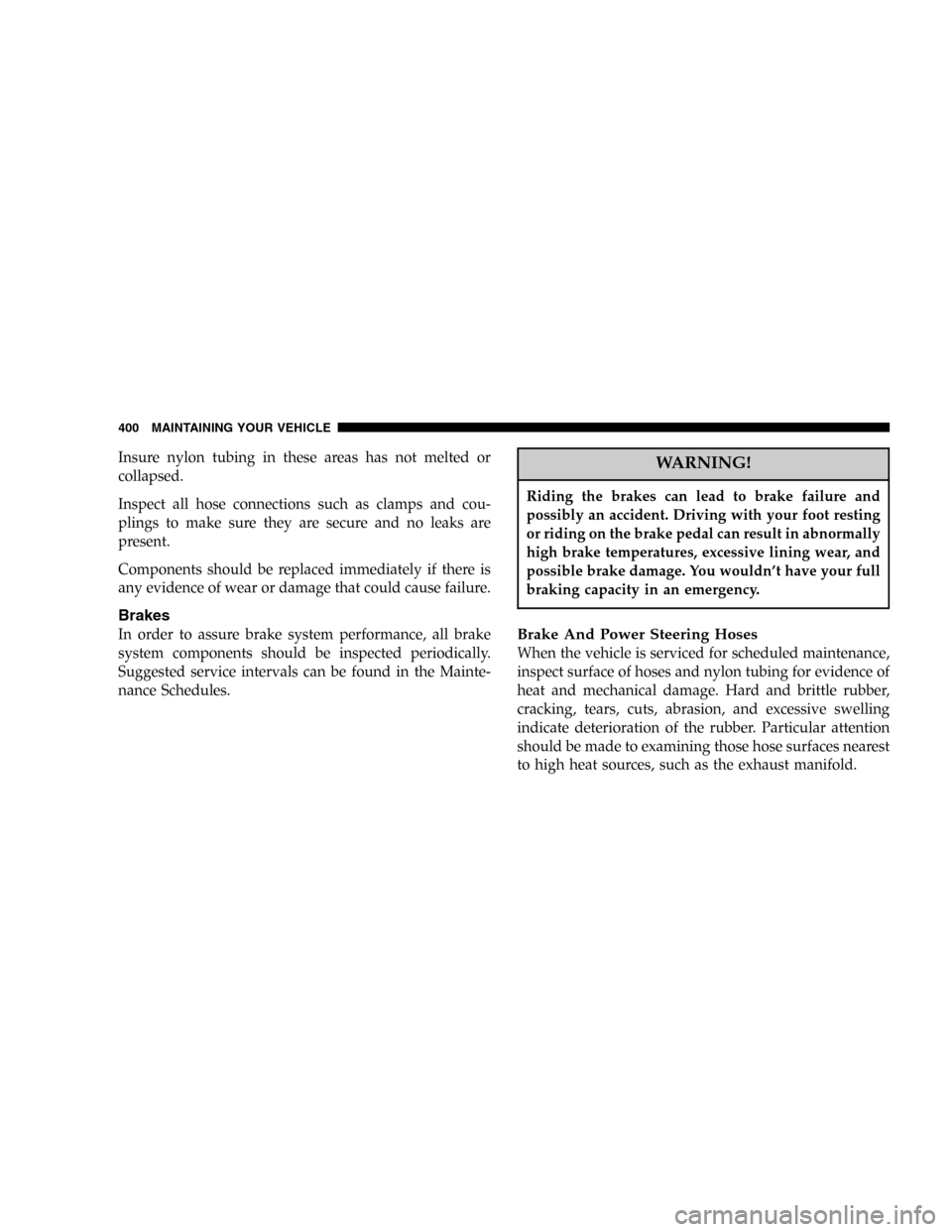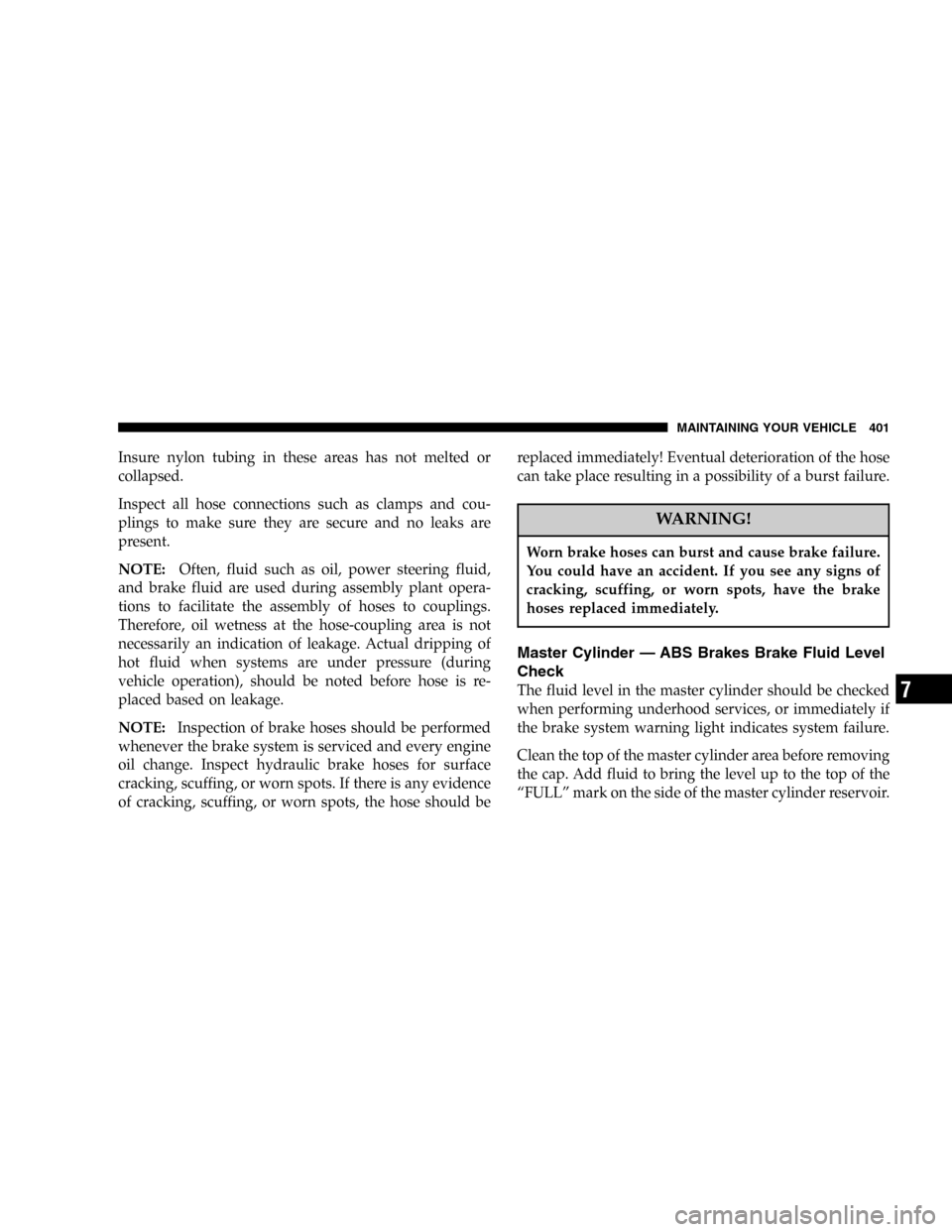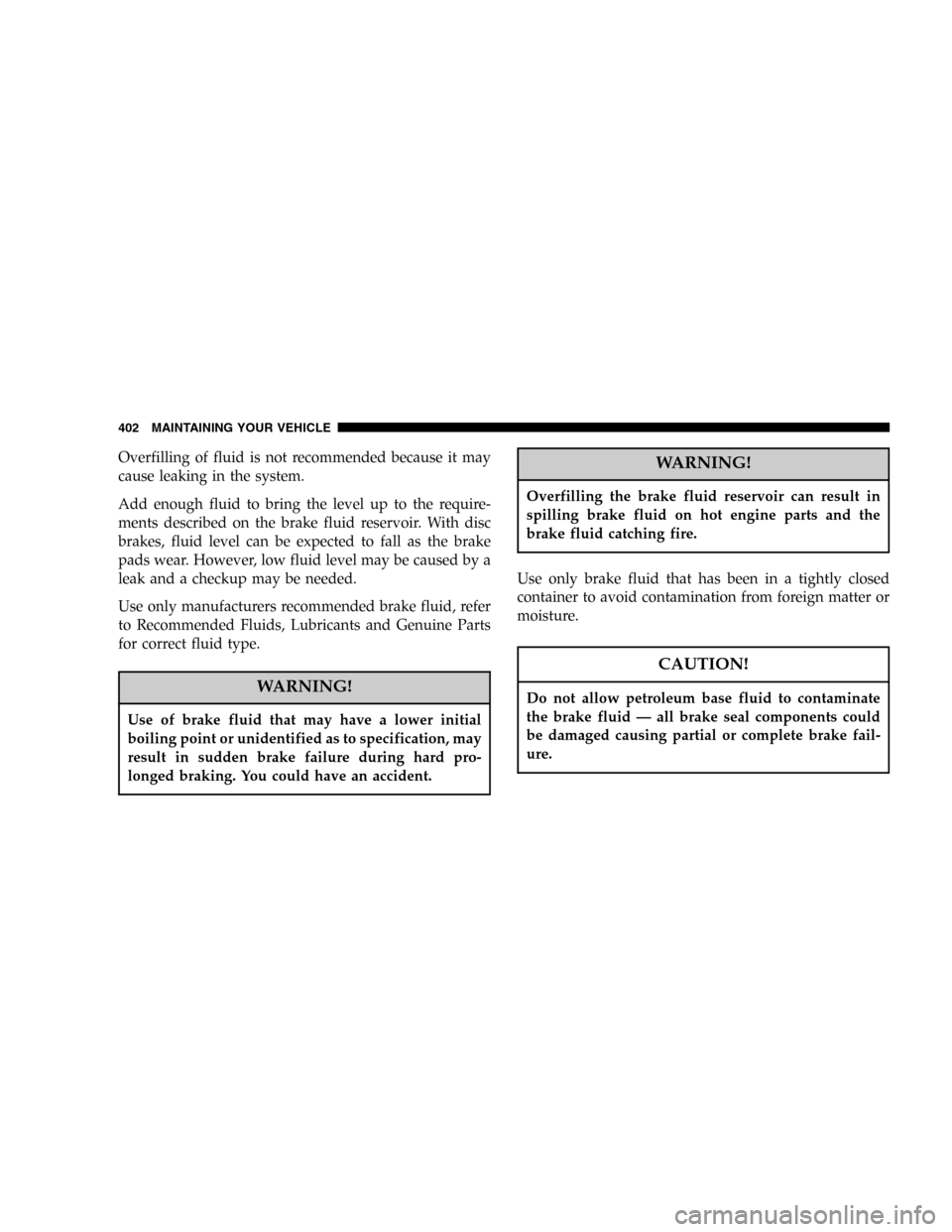Page 368 of 472

WARNING!
•Do not attempt to push or tow your vehicle to get it
started. Vehicles equipped with an automatic transmis-
sion cannot be started this way. Unburned fuel could
enter the catalytic converter and once the engine has
started, ignite and damage the converter and vehicle. If
the vehicle has a discharged battery, booster cables may
be used to obtain a start from another vehicle. This type
of start can be dangerous if done improperly, so follow
this procedure carefully.
•Battery fluid is a corrosive acid solution; do not allow
battery fluid to contact eyes, skin or clothing. Don’t lean
over battery when attaching clamps or allow the clamps
to touch each other. If acid splashes in eyes or on skin,
flush contaminated area immediately with large quan-
tities of water.
•A battery generates hydrogen gas which is flammable
and explosive. Keep flame or spark away from the vent
holes. Do not use a booster battery or any other booster
source with an output that exceeds 12 volts.
1. Wear eye protection and remove any metal jewelry
such as watch bands or bracelets that might make an
inadvertent electrical contact.
2. When boost is provided by a battery in another
vehicle, park that vehicle within booster cable reach and
without letting the vehicles touch. Set the parking brake,
place the automatic transmission in PARK and turn the
ignition switch to the OFF position for both vehicles.
3. Turn off the heater, radio and all unnecessary electrical
loads.
4. Connect one end of a jumper cable to the positive
terminal of the discharged battery. Connect the other end
of the same cable to the positive terminal of the booster
battery.
368 WHAT TO DO IN EMERGENCIES
Page 374 of 472

▫Steering Shaft Seal....................391
▫Steering Linkage......................391
▫Drive Shaft Universal Joints..............391
▫Body Lubrication.....................392
▫Windshield Wiper Blades................392
▫Windshield And Rear Window Washers.....393
▫Exhaust System......................393
▫Cooling System.......................394
▫Hoses And Vacuum/Vapor Harnesses.......399
▫Brakes.............................400
▫Master Cylinder—ABS Brakes Brake Fluid
Level Check.........................401
▫Fuel System Hoses....................403▫Automatic Transmission................403
▫Front And Rear Wheel Bearings...........406
▫Appearance Care And Protection
From Corrosion......................406
▫Cleaning The Instrument Panel And Underseat
Cup Holders........................411
�Integrated Power Module (IPM)............412
�Vehicle Storage........................415
�Replacement Light Bulbs.................416
�Bulb Replacement......................417
▫Headlights..........................417
▫Front Park/Turn Signal And
Sidemarker Lights.....................418
▫Front Fog Light......................419
374 MAINTAINING YOUR VEHICLE
Page 400 of 472

Insure nylon tubing in these areas has not melted or
collapsed.
Inspect all hose connections such as clamps and cou-
plings to make sure they are secure and no leaks are
present.
Components should be replaced immediately if there is
any evidence of wear or damage that could cause failure.
Brakes
In order to assure brake system performance, all brake
system components should be inspected periodically.
Suggested service intervals can be found in the Mainte-
nance Schedules.
WARNING!
Riding the brakes can lead to brake failure and
possibly an accident. Driving with your foot resting
or riding on the brake pedal can result in abnormally
high brake temperatures, excessive lining wear, and
possible brake damage. You wouldn’t have your full
braking capacity in an emergency.
Brake And Power Steering Hoses
When the vehicle is serviced for scheduled maintenance,
inspect surface of hoses and nylon tubing for evidence of
heat and mechanical damage. Hard and brittle rubber,
cracking, tears, cuts, abrasion, and excessive swelling
indicate deterioration of the rubber. Particular attention
should be made to examining those hose surfaces nearest
to high heat sources, such as the exhaust manifold.
400 MAINTAINING YOUR VEHICLE
Page 401 of 472

Insure nylon tubing in these areas has not melted or
collapsed.
Inspect all hose connections such as clamps and cou-
plings to make sure they are secure and no leaks are
present.
NOTE:Often, fluid such as oil, power steering fluid,
and brake fluid are used during assembly plant opera-
tions to facilitate the assembly of hoses to couplings.
Therefore, oil wetness at the hose-coupling area is not
necessarily an indication of leakage. Actual dripping of
hot fluid when systems are under pressure (during
vehicle operation), should be noted before hose is re-
placed based on leakage.
NOTE:Inspection of brake hoses should be performed
whenever the brake system is serviced and every engine
oil change. Inspect hydraulic brake hoses for surface
cracking, scuffing, or worn spots. If there is any evidence
of cracking, scuffing, or worn spots, the hose should bereplaced immediately! Eventual deterioration of the hose
can take place resulting in a possibility of a burst failure.
WARNING!
Worn brake hoses can burst and cause brake failure.
You could have an accident. If you see any signs of
cracking, scuffing, or worn spots, have the brake
hoses replaced immediately.
Master Cylinder—ABS Brakes Brake Fluid Level
Check
The fluid level in the master cylinder should be checked
when performing underhood services, or immediately if
the brake system warning light indicates system failure.
Clean the top of the master cylinder area before removing
the cap. Add fluid to bring the level up to the top of the
“FULL”mark on the side of the master cylinder reservoir.
MAINTAINING YOUR VEHICLE 401
7
Page 402 of 472

Overfilling of fluid is not recommended because it may
cause leaking in the system.
Add enough fluid to bring the level up to the require-
ments described on the brake fluid reservoir. With disc
brakes, fluid level can be expected to fall as the brake
pads wear. However, low fluid level may be caused by a
leak and a checkup may be needed.
Use only manufacturers recommended brake fluid, refer
to Recommended Fluids, Lubricants and Genuine Parts
for correct fluid type.
WARNING!
Use of brake fluid that may have a lower initial
boiling point or unidentified as to specification, may
result in sudden brake failure during hard pro-
longed braking. You could have an accident.
WARNING!
Overfilling the brake fluid reservoir can result in
spilling brake fluid on hot engine parts and the
brake fluid catching fire.
Use only brake fluid that has been in a tightly closed
container to avoid contamination from foreign matter or
moisture.
CAUTION!
Do not allow petroleum base fluid to contaminate
the brake fluid—all brake seal components could
be damaged causing partial or complete brake fail-
ure.
402 MAINTAINING YOUR VEHICLE
Page 404 of 472

CAUTION!
Using a transmission fluid other than the manufac-
turers recommended fluid may cause deterioration
in transmission shift quality and/or torque converter
shudder. Using a transmission fluid other than the
manufacturers recommended fluid will result in
more frequent fluid and filter changes. Refer to
Recommended Fluids, Lubricants and Genuine Parts
for correct fluid type.
Procedure For Checking Fluid Level
The fluid level in the automatic transmission should be
checked whenever the vehicle is serviced. Operation with
an improper fluid level will greatly reduce the life of the
transmission and of the fluid.
To properly check the automatic transmission fluid level,
the following procedure must be used:
1. The vehicle must be on level ground.
2. The engine should be running at curb idle speed for a
minimum of 60 seconds.
3. Fully apply parking brake.
4. Place the gear selector momentarily in each gear
position ending with the lever in P (PARK). Wipe the area
around the dipstick clean to eliminate the possibility of
dirt entering the transmission.
404 MAINTAINING YOUR VEHICLE
Page 413 of 472
Cavity Maxi Fuse Description
F4 30 Amp
PinkFront Wipers
F9 40 Amp
GreenAnti-Lock Brake System
(ABS) Pump
F10 40 Amp
GreenFront Blower
F13 40 Amp
GreenElectronic Back Light (EBL)
F19 40 Amp
GreenBody Control Module
(BCM) Feed 1
F20 30 Amp
PinkCentral Amplifier
F22 30 Amp
PinkSeats
F27 40 Amp
GreenRadiator FanCavity Maxi Fuse Description
F28 40 Amp
GreenPower Windows
F30 40 Amp
GreenHeadlight Washers (Export
Only)
F31 40 Amp
GreenPower Sliding Door
F32 40 Amp
GreenPower Liftgate
MAINTAINING YOUR VEHICLE 413
7
Page 414 of 472
Cavity Mini Fuse Description
F1 20 Amp Yel-
lowFog Lights
F2 15 Amp Blue Left Park/Tail Light
F3 15 Amp Blue Right Park/Tail Light
F5 20 Amp Yel-
lowRDO/IP Ignition
F6 20 Amp Yel-
low12 Volt Out Ignition or
Battery
F8 20 Amp Yel-
lowHorn
F11 20 Amp Yel-
lowEWD/ Rear Wiper
F12 25 Amp Clear Rear Blower
F14 20 Amp Yel-
lowIgnition Off Draw (IOD)
F15 20 Amp Yel-
lowElectronic Automatic
Transaxle (EATX) BatteryCavity Mini Fuse Description
F15 25 Amp Clear ASD
F17 20 Amp Yel-
lowFuel Pump
F18 15 Amp Blue A/C Clutch
F21 25 Amp Clear Anti-Lock Brake System
(ABS) Module
F23 10 Amp Red Ignition Switch
F24 20 Amp Yel-
lowHazard
F26 20 Amp Yel-
lowStop Lamp
F33 15 Amp Blue Front/Rear Washer
20 Amp Yel-
lowSpare (IOD)
414 MAINTAINING YOUR VEHICLE